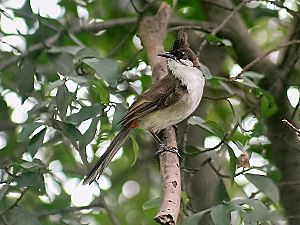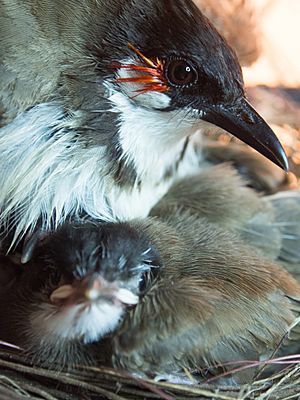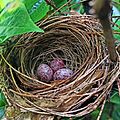Red-whiskered bulbul facts for kids
Quick facts for kids Red-whiskered bulbul |
|
|---|---|
 |
|
| Conservation status | |
| Scientific classification | |
| Kingdom: | |
| Phylum: | |
| Class: | |
| Order: | |
| Family: | |
| Genus: |
Pycnonotus
|
| Binomial name | |
| Pycnonotus jocosus (Linnaeus, 1758)
|
|
The red-whiskered bulbul (Pycnonotus jocosus) is a type of bird. It belongs to the Pycnonotidae family. These birds are mostly found in tropical parts of Asia. They have also been introduced to many other warm areas around the world. Red-whiskered bulbuls eat fruits and small insects. They are known for their loud calls and are very common in hill forests and city gardens.
Contents
What They Look Like
The red-whiskered bulbul is about 20 centimeters (8 inches) long. It has brown feathers on its back and whitish feathers underneath. There's a dark mark on its chest near the shoulders.
This bird has a tall, pointed black crest on its head. It also has a bright red patch on its face and a thin black line that looks like a mustache. Its tail is long and brown with white tips on the feathers. The area under its tail is red. Young bulbuls do not have the red patch behind their eye, and their tail area is more orange-brown.
Their loud call sounds like "kink-a-joo" or "pleased to meet you." They often make a scolding, chattering song. You might hear them more often than you see them, but they like to perch high up in trees, especially in the mornings. These birds usually live for about 11 years.
Where They Live
Red-whiskered bulbuls prefer areas with light woods, open spaces with bushes, and farmland. Sometimes, large groups of them would suddenly appear in places like Madras (now Chennai) in India.
These birds have also started living in new places like Australia, Los Angeles, Hawaii, and Florida in the United States. You can also find them on islands like Mauritius and Assumption Island. In Florida, they live in a very small area, so their numbers could easily drop.
From 2013 to 2015, efforts were made to remove them from Assumption Island. This was to stop them from spreading to nearby Aldabra, which is a large tropical island without many introduced birds.
In 1880, the Zoological and Acclimatization Society brought the red-whiskered bulbul to Sydney, Australia. By 1920, they were common in the suburbs and slowly spread about 100 kilometers (60 miles) away. They are now also seen in Melbourne and Adelaide, though it is not clear how they got to these cities.
How They Live and Interact
On the island of Réunion, red-whiskered bulbuls helped spread plants that were not native to the island, like Rubus alceifolius. In Florida, they eat fruits and berries from many different plants, including loquat, Lantana species, Brazilian pepper, and figs. In Mauritius, they help spread Ligustrum robustum and Clidemia hirta. Seeds that pass through their digestive system often grow better.
Bulbuls on Réunion Island have changed over 30 years. Their beaks now look different depending on the types of food they eat.
Reproduction and Life Cycle
The breeding season for red-whiskered bulbuls varies by location. In southern India, it's mostly from December to May. In northern India, it's from March to October. They might breed once or twice a year.
To attract a mate, the male bird bows its head, spreads its tail, and droops its wings. The nest is shaped like a cup and is built in bushes, on thatched roofs, or in small trees. They weave it from thin twigs, roots, and grasses. They might even add things like bark strips, paper, or plastic bags.
A female usually lays two to three eggs. The eggs are pale purple with speckles that become blotches at the wider end. They are about 21 mm long and 16 mm wide. The eggs hatch after 12 days. Both parents help raise the young birds.
Young birds are first fed caterpillars and insects. As they grow, their diet changes to fruits and berries. When they are very young, chicks only have downy feathers in certain areas. Larger birds like the greater coucal and crows sometimes eat the eggs and chicks.
During breeding season, these birds protect an area of about 3,000 square meters (32,000 square feet). They often sleep together in large groups of 100 or more birds.
What They Eat
Red-whiskered bulbuls eat fruits, including those from the yellow oleander plant, which are poisonous to mammals. They also feed on nectar and insects.
Images for kids
See also
 In Spanish: Bulbul orfeo para niños
In Spanish: Bulbul orfeo para niños






